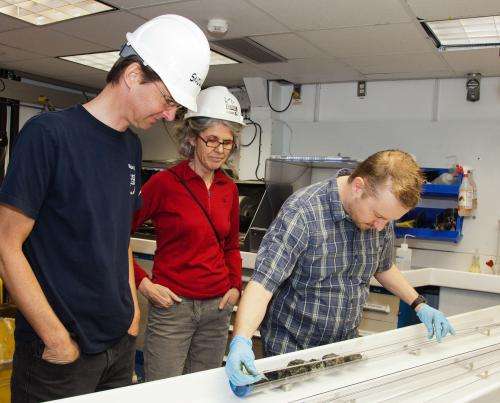Rocks reveal ocean ridge development

A University of Wyoming husband-and-wife research team was part of a larger group that has made the first significant recovery of layered igneous rocks from the Earth's lowest ocean crust.
The discovery—found in the "Hess Deep Rift" in the Pacific Ocean—confirms a long-held belief among geologists that such rocks are a key part of the lower ocean crust formed at fast-spreading ridges.
Michael Cheadle, an associate professor, and Professor Barbara John, both in UW's Department of Geology and Geophysics, are two co-writers (30 in all) of a research paper, titled "Primitive Layered Gabbros from Fast-Spreading Lower Oceanic Crust," published in the new issue of Nature.
The two were part of a 26-member international research team that sailed to the Hess Deep, a deep scar in the Pacific Ocean's sea floor, between December 2012 and January 2013. Their mission was to study rocks sampled about 3-4 kilometers below the sea floor in an effort to better understand how the Earth's crust is formed.
"To me, the key thing for the public is that, for the first time ever, we recovered rocks from the lower-most part of the ocean's crust. This hasn't been accomplished before," Cheadle says. "For 50 years, people have tried to drill to this depth or deeper, but have been unsuccessful."
"The rocks were in situ, or in place," John adds. "This is not rock exposed at the surface because the tectonic plates collided and formed mountains, but were recovered beneath the sea floor where they were formed."
The world's oceanic crust—which makes up 70 percent of the Earth's surface—is formed at mid-ocean ridges. At these ridges, volcanoes sit above magma chambers, much like volcanoes one would see in Hawaii, John says. These magma chambers are fed from below by the melting mantle. Oceanic crust is made when this magma freezes.
"What we were drilling was the frozen remains of what once was a magma chamber," Cheadle says.
The cruise was part of the Integrated Ocean Drilling Program (IODP), a multinational research project that operates up to three research vessels that sail the world's oceans. The ships drill bore holes to collect samples of rock and sediment from below the sea floor to address questions about geology, climate, oceanography and natural hazards, including earthquakes. The U.S., Japan, Europe and several other countries were involved in the 50-day, multimillion-dollar operation, funded, in part, by the U.S. National Science Foundation's (NSF) Division of Ocean Sciences.
During their voyage, Cheadle and John studied the geology of the recovered core samples. They measured rock fractures and faults, and examined the crystals that made up the rock.
And they found something that really surprised them. Crystals of olivine, a common mineral in ocean crust, had a tree-like branch pattern on the core samples. Cheadle used the term "skeletal" and likened its growth to ice crystals on a car windshield. John described it as similar to the ice that forms on a frozen puddle: large crystals with a delicate branching structure, unlike any seen before in the lower crust.
Because the rocks were found 3-4 kilometers (1.8-2.5 miles) beneath the ocean floor, the rocks should have cooled much more slowly and not left such a dramatic pattern, the two say.
"That was totally unexpected," Cheadle says. "That (tree branch crystal) shape indicates the mineral grew very quickly."
"There's something going on there that we don't understand," John says.
During their research expedition, Cheadle and John, like the other researchers aboard, took turns communicating to classrooms around the globe via Skype.
"We'd tell a little story of what we were working on," says John, who mentioned speaking to a group of middle school students from France. "They had excellent questions asked in English—something I wish our system could do better with here in the United States."
More information: The paper is now online at http://www.nature.com/nature/journal/vaop/ncurrent/full/nature12778.html.
Journal information: Nature
Provided by University of Wyoming




















